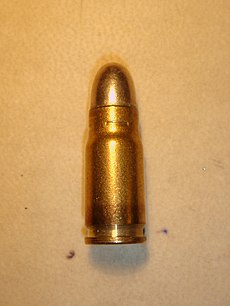7.65×21mm Parabellum
| 7.65×21mm Parabellum | ||||||||
|---|---|---|---|---|---|---|---|---|

7.65mm Parabellum, Swiss manufacture (Thun, 1973)
|
||||||||
| Type | Pistol | |||||||
| Place of origin | German Empire | |||||||
| Service history | ||||||||
| In service | 1898–1949 | |||||||
| Used by | Germany, Switzerland, Finland | |||||||
| Wars | World War I-present | |||||||
| Production history | ||||||||
| Designer | Georg Luger and Hugo Borchardt | |||||||
| Designed | 1898 | |||||||
| Manufacturer | Deutsche Waffen und Munitionsfabriken | |||||||
| Specifications | ||||||||
| Parent case | 7.65×25mm Borchardt | |||||||
| Case type | Rimless, bottleneck | |||||||
| Bullet diameter | 7.85 mm (0.309 in) | |||||||
| Neck diameter | 8.43 mm (0.332 in) | |||||||
| Base diameter | 9.93 mm (0.391 in) | |||||||
| Rim diameter | 9.98 mm (0.393 in) | |||||||
| Rim thickness | 1.22 mm (0.048 in) | |||||||
| Case length | 21.59 mm (0.850 in) | |||||||
| Overall length | 29.85 mm (1.175 in) | |||||||
| Case capacity | 0.93 cm3 (14.4 gr H2O) | |||||||
| Rifling twist | 275 mm (1 in 10.83 in) | |||||||
| Primer type | Berdan or Boxer Small pistol | |||||||
| Maximum pressure | 235.00 MPa (34,084 psi) | |||||||
| Ballistic performance | ||||||||
|
||||||||
| Source(s): Modern Firearms & Ammunition, Pistol Ammunition | ||||||||
The 7.65×21mm Parabellum (designated as the 7,65 Parabellum by the C.I.P. and also known as .30 Luger and 7.65mm Luger) is a pistol cartridge that was introduced in 1898 by German arms manufacturer Deutsche Waffen und Munitionsfabriken (DWM) for their new Pistol Parabellum. The primary designers were firearms designers Georg Luger and Hugo Borchardt, who developed the round from the earlier 7.65×25mm Borchardt while working at DWM.
In 1897, the C-93 Borchardt pistol was submitted for testing to the Swiss Military Trials Committee. The Committee found the Borchardt too heavy and unwieldy to serve as a military sidearm. Georg Luger was tasked by DWM with improving upon the Borchardt pistol. He developed the 7.65×21mm Parabellum cartridge from the 7.65×25mm Borchardt. By shortening the cartridge case, Luger was able to design a narrower grip, and the toggle action required a shorter stroke than in the original Borchardt design. A transitional Borchardt-Luger model in the new caliber was submitted to the Swiss commission in 1898. After further improvements, the final result became the DWM Pistole-Parabellum ("Luger pistol"). The loading for the new cartridge was standardized and mass production began in 1900–1901 in DWM's factory in Karlsruhe, Germany.
Around 1903, a separate load was developed for Parabellum carbines, with approximately 20% more powder (increased from the standard 0.32–0.35 g to 0.4 g) and a blackened cartridge case. This carbine load was manufactured until sometime after World War I.
Since its introduction, 7.65×21mm Parabellum ammunition has been manufactured in several countries for both domestic use and for export, including Germany, Switzerland, Finland, France, Portugal, Brazil, the United Kingdom and the United States.
...
Wikipedia
